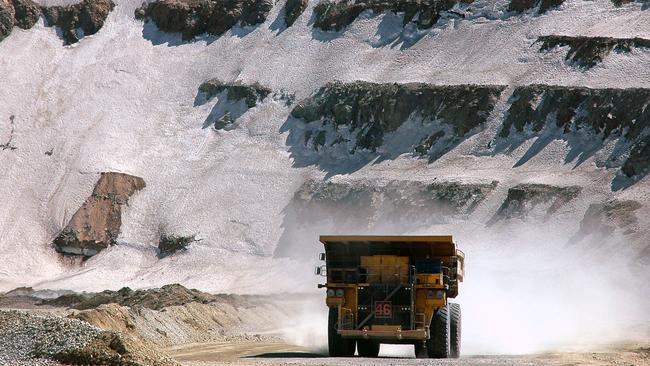Copper wars are on as BHP bets it all on Anglo American
In making the high-risk $60bn mega-deal, BHP’s boss Mike Henry needs to prove the miner is not slipping back to its destructive old habits.

Business
Don't miss out on the headlines from Business. Followed categories will be added to My News.
BHP boss Mike Henry’s high-stakes move on UK giant Anglo American is a grab for some of the last world class copper mines on the market.
Valuing Anglo at $60bn, it is an all-or-nothing bet by the Australian mining giant on the metal that is set to underpin the world’s green energy shift.
A deal would also offer the secondary prize of Anglo’s high-quality met coal mines in Australia, giving BHP synergies as well as options for the future of its Australian coal business. BHP’s boss has been mulling whether to go bigger in steelmaking coal or get out of the carbon-intensive commodity over time.
But it comes with real risks. Investors are fearful of a return to BHP’s bad old habits when it comes to deal making, with the memories of Billiton still lingering.
Henry has tried to break away from the past and staked his leadership on discipline while trying to simplify and strip BHP back to its very core to power investor returns.
But the move on Anglo – unveiled by BHP in London on Thursday night – threatens to up-end his work so far. As well as copper and coal, and mid-sized Brazilian iron ore, the buyout delivers a grab-bag of lower-returning and capital-hungry operations from manganese to diamonds. These are the very things the big Australian has spent the past two decades trying to extract itself from.
And worryingly, Anglo has an inherently complex corporate structure that could take years for BHP to untangle. BHP’s shares fell 4 per cent in London opening as it confirmed the terms of the takeover approach. BHP’s all share outlay would be closer to $40.5bn given it plans to exclude some of Anglo’s existing businesses from the transaction.
For BHP, Anglo is more of an opportunistic than calculated play. And the speed of the approach is a rare break of character for the BHP boss. He is a chief executive who sweats, punishes then dissects and reassembles the numbers on any proposal until a business case finally emerges.
Rivals say Henry is often too cautious. This is telling in that he has given himself at least eight months to study and weigh up what to do with his loss-making nickel business in Western Australia.
Still, opportunity can’t be ignored when it knocks.
And the opportunity follows Anglo’s newish chief executive Duncan Wanblad recently vowing to put his entire portfolio under the microscope ranking their growth prospects and whether they even fit in with Anglo’s longer-term future.
In February the Anglo boss declared: “Every asset in the portfolio has to play its role.”
Wanblad’s review followed Anglo’s shareholders agitating for the miner to unlock more value from its broad sweep of commodities. Anglo’s sub-scale position in some markets and group complexity, including the partial ownership stakes of platinum and iron ore, is a turn-off to many. In the past two years, Anglo’s shares are down 30 per cent while BHP is up 10 per cent.
However, if Wanblad’s portfolio review leads to some of Anglo’s lower-valued businesses being sold or spun off, this would ultimately deliver a re-rating for Anglo’s well-regarded copper and coal businesses with a higher share price multiple.
In short, BHP’s Henry is calculating it is cheaper to move now and do the renovation work himself, rather than pay a premium later on.
The all-share approach was made to Anglo’s board and offers a 19 per cent premium to the analyst median net asset value of Anglo.
The deal would involve the simultaneous spin-out of Anglo’s partially-listed platinum and Kumba iron ore operations in South Africa.
This sweetener in BHP’s proposal is important, given it plays to the break-up of the business that Anglo’s big shareholders have been pushing for. With BHP cool on these businesses, Anglo’s shareholders would still retaining some of the more valuable cash generating units in a separate company.
In a statement BHP said the combination “would bring together the strengths of BHP and Anglo American in an optimal structure”.
“Anglo American would bring its assets and long-term growth potential. BHP would bring its higher margin cash generative assets and growth projects along with its larger free cash flows and stronger balance sheet.”
Billiton reboot?
The all-share approach made to Anglo’s board last week marks the biggest deal for the miner since it made an aborted merger approach for Rio Tinto during the global financial crisis. But this one has more parallels with BHP’s painful US$37bn Billiton merger two decades ago.

Widely-regarded at the time as a reverse takeover, the Australian miner emerged with just 58 per cent of merged BHP Billiton, despite the BHP side generating nearly 70 per cent of earnings. Billiton threw BHP into countries and downstream operations like aluminium smelting the Australian miner had little experience with. Ultimately most of Billiton was spun out in the form of ASX-listed South32 more than 15 years later. And to show the past was behind it, shortly after the spin-off BHP quietly buried the “Billiton” name down the bottom of one of its Pilbara iron ore pits.
Today BHP’s model is built around predictable high-volume, top tier mines. It has little long-term interest in diamonds, platinum group metals, manganese and nickel.
However, the CEO would already be planning an exit ramp for Anglo’s manganese, South African nickel and iron ore as well as the reputationally risky De Beers diamonds business. BHP confirmed these operations would be subject to a strategic review after the deal’s completion.
Glencore for one has shown it has been a willing buyer of mines. Even South32 has previously expressed an interest in Anglo’s manganese businesses given the overlap they share in joint ventures.
Anglo, which is scheduled to hold is annual meeting next week, said it was reviewing the proposal.
Copper first
Through a ruthless focus on capital allocation in just four years BHP’s Henry has undertaken the biggest reshaping of the modern BHP.
Through the monster $60bn selldown of the “foundation” oil and gas operations to Woodside, collapsing the dual-listed structure and now with the likely shutdown of Australia nickel he has arguably done more than his predecessors to strip back BHP to the core.

Henry too has given the green light to a multi-decade expansion of Canadian potash, even before the first stage of the project has mined a single tonne.
And with his biggest acquisition so far, Henry has already doubled down on copper through last year’s $9.6bn Oz Minerals buyout. In a forerunner to Anglo, that deal also came with unwanted nickel assets but it didn’t weaken Henry’s determination for Oz.
Oz is now being used as a platform to build a copper super hub in South Australia which, combined with the Olympic Dam assets, has set down an aspirational target of producing 500,000 tonnes of the metal per year from the region.
But make no mistake, copper remains the prize for BHP, with Anglo’s long-life mines in South America generating more than $US3.2bn in earnings last year and having strong expansion prospects. Already BHP is one of the world’s biggest copper producers and the combination would consolidate its lead position for decades to come.
Being the biggest copper producer would give BHP a more balanced earnings stream, reducing its reliance on iron ore, particularly as China’s economy starts its long term moderation. At 70 per cent of earnings, iron ore is doing all the heavy lifting for BHP
More copper will be needed over the next three decades to meet the demand for batteries, EVs, windmills and rewiring the energy grid. The metal is now pushing two-year highs, even as the outlook for global economy remains uncertain. Rival Rio Tinto has consolidated its position in the metal with its giant Oyu Tolgoi copper mine in Mongolia and growth options for Kennecott in Utah. Let the copper wars begin.
johnstone@theaustralian.com.au
More Coverage
Originally published as Copper wars are on as BHP bets it all on Anglo American





